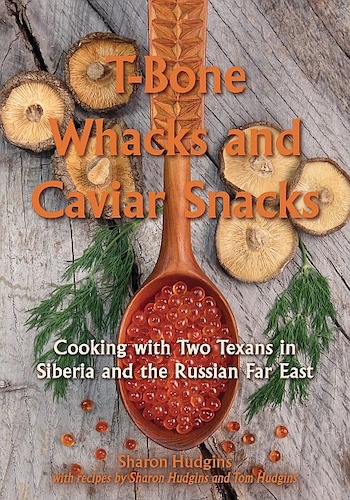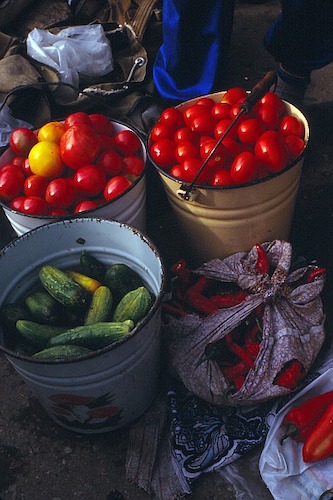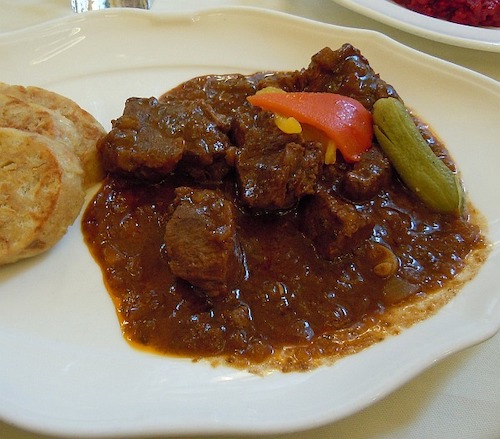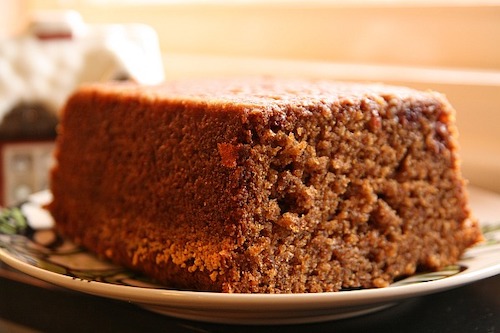Special Feature: Products Sally Recommends
comfort foods in a crisis
How an Texan's experiences in Siberia helped her cope with social isolation in today's pandemic
by
Sharon Hudgins

Recently, as the coronavirus pandemic spread across the United States and many of us were cooped up at home, I thought about other times in my life when I was isolated with my husband in a small house or apartment building, in places as far-flung as a remote cottage in Scotland and two tiny apartments in Siberia. And I remembered how cooking together was one of the best ways we kept "cabin fever" at bay (most of the time, anyway). Those long-ago experiences were good training for what all of us have been going through today.
In the mid-1990s my husband and I moved to Siberia to work as university professors, shortly after the collapse of the Soviet Union. We arrived just in time for an economic depression that makes this year's downturn in America look like a minor blip on a chart. Living in two different cities, in ugly Soviet-style high-rise apartment buildings, we had to contend with erratic electricity and undependable heating, a major challenge during the Siberian winter. Drinking water from our taps ranged in color from clear to amber, orange, purple, or black, with accompanying aromas of ham, rotten eggs, petroleum, or fish. (In one city, the water supply was also contaminated with cholera bacteria.) So all water for drinking, cooking, and tooth brushing had to be boiled, cooled, and pumped through a water filter every day before using.
There were no modern supermarkets, very few places to eat out, no phone, no TV, few outside sources of news, and initially no Internet. We didn't even have a car for going grocery shopping. Thank goodness we didn't have to deal with a global pandemic, too.

Shopping for food was a daily chore after work and on weekends, as we scoured the sparsely stocked stores and better-supplied farmers' markets for whatever products might be available that day, even that hour. Eggs disappeared from the shelves for a couple of weeks at a time. Sugar couldn't be found anywhere for two months. Flour—scooped out of wooden barrels and weighed on an old-fashioned scale—was often so adulterated with impurities that we had to sift them out before using it. During the year and a half that we were in Russia, life began to improve a bit, but never reached the level of material variety and abundance that people took for granted in the West.
Despite those difficulties, cooking at home every day was not only necessary, but also a way to brighten up the dark Siberian winters when we were cooped up in our apartments for days at a time. We enjoyed making meals from whatever ingredients happened to be available—even cold meals when we had no electricity for cooking. We experimented with new recipes from friends and cookbooks. We made tried-and-true dishes from recipes we'd brought with us from home. And we gave informal dinner parties with friends and colleagues to help everyone make it through hard times. We even managed to joyously celebrate Christmas, New Year, and Easter, Thanksgiving, birthdays, and Mardi Gras.
After those experiences, I chuckled at people in America today who got upset about not being able to eat at their favorite fast-food restaurant. Or who hoarded six months' supply of toilet paper. Or complained that a store was temporarily out of their preferred brand of breakfast cereal. But I'm not being critical. Like so many of my fellow Americans, I feel the pain, too. I've lost some of the contract jobs I was counting on this year. All my travel plans have been canceled. And by now—given the "six degrees of separation" between any of us—most of us know at least one other person who has contracted this terrible virus. Yes, 2020 is a much different place than it was just a few months ago.
Recently most Americans have been stuck at home by necessity, not choice—many of us confined to a limited space along with bored kids, cranky spouses, and insistent pets, all of whom want (and need) to be fed. That's when comfort foods can help us keep calm in this crisis, especially when faced with forces beyond our control. We can be in control in our kitchens.
Since mid-March, my husband and I have been trying out new recipes from cookbooks that we didn't have time to read before. We've been gleaning unusual recipes from trusted sources online. And we've enjoyed making our own favorite dishes from my latest cookbook, T-Bone Whacks and Caviar Snacks: Cooking with Two Texans in Siberia and the Russian Far East. Those comfort foods sustained us through challenging times in Russia. So they're perfect for helping us cope with the current crisis, too, as we retreat to the familiar when faced with the unknown.
Here are two of my favorite easy-to-make, down-home dishes from T-Bone Whacks and Caviar Snacks, which are guaranteed to lower the anxiety level in your kitchen. And you probably have all the ingredients in your pantry and fridge already—unless you stocked up on too much toilet paper when the pandemic hit and now don't have space for food in your house.
------------------------------
GOULASH STEW WITH MUSHROOMS

I learned to make this hearty goulash stew when we lived in Europe, where it's a popular dish at Czech, German, and Hungarian beer halls. I also enjoyed making it in Siberia, where it was a welcome comfort food on cold winter nights.
1/4 cup lard or sunflower oil
2 large onions, chopped
1/4 pound bacon, finely chopped
3 tablespoons sweet (mild) Hungarian paprika*
1 tablespoon hot Hungarian paprika*
1-1/2 pounds boneless beef (chuck or shank), or boneless pork shoulder, cut into 1-inch cubes
1/2 pound mushrooms, cleaned and quartered lengthwise
4 large garlic cloves, minced
1 tablespoon tomato paste
1 cup beef stock
1 teaspoon salt
1 teaspoon freshly ground black pepper
Garnish: 1 small onion, sliced thinly into rings
Grated fresh horseradish
*Or a mixture of mild and hot paprikas, to taste. Smoked paprika is a good substitute, too.
● Melt the lard or heat the sunflower oil in a 4-quart stovetop casserole or stockpot. Sauté the chopped onions and bacon over medium-high heat until the onions are translucent and very soft. Remove the pot from the heat, sprinkle the paprika over the onions and bacon, and stir to combine well. Add the cubed meat and mix well.
● Return the pot to the stove and cook, stirring constantly, over medium heat until the meat is browned on all sides. Stir in the mushrooms and garlic.
● Dissolve the tomato paste in the beef stock and add it to the pot, along with the salt and pepper, stirring to mix well. Bring the mixture to a boil over high heat, then reduce the heat to very low, cover, and simmer for 45 minutes.
● Serve hot, garnished with fresh onion rings and a sprinkling of freshly grated horseradish, and accompanied by boiled potatoes or egg noodles and plenty of cold beer.
● Makes 6 servings.
From T-Bone Whacks and Caviar Snacks: Cooking with Two Texans in Siberia and the Russian Far East (University of North Texas Press, 2018)
-----------------------------------------
GINGERBREAD SQUARES

I first made this spicy gingerbread when we lived in a cottage in the Scottish Highlands, where I baked it in our fireplace oven. I liked the recipe so much that I took it to Siberia, too. This gingerbread is perfect to make in places where ingredients are scarce or budgets are tight, because it requires no butter, milk, or eggs.
► NOTE: It is important to use an 8-inch square baking pan for this recipe.
2 cups all-purpose flour
3/4 cup dark brown sugar, firmly packed
2 teaspoons baking powder
1-1/2 teaspoons ground ginger
1 teaspoon ground cinnamon
1/2 teaspoon ground cloves
1/2 teaspoon ground nutmeg
1/4 teaspoon salt
3/4 cup very hot tap water
1/2 cup treacle (or unsulfured dark molasses)
1/4 cup vegetable oil
● Preheat the oven to 350° F. Butter or oil an 8-inch square baking pan.
● Whisk the flour, sugar, baking powder, ginger, cinnamon, cloves, nutmeg, and salt together in a medium bowl, until well combined. Mix the hot water, treacle (or molasses), and oil in a separate bowl, stirring well to combine.
● Make a well in the center of the dry ingredients, pour in the liquid mixture, and stir gently, just until the ingredients are blended and no large lumps remain. Do not overbeat or the gingerbread will be tough.
● Spread the batter evenly in the baking pan. Bake at 350° F. for 25 to 30 minutes, or until a skewer inserted in the center comes out clean. Let the gingerbread cool in the pan, set on a wire rack, then cut into 2-inch squares. Wrap leftovers tightly in foil or plastic wrap for storage.
● Makes: 16 squares.
► NOTE: This dark-colored, densely textured gingerbread tastes even better the day after baking, when the flavors have had time to develop. For a lighter-colored, more delicate tasting version, substitute white sugar and honey for the brown sugar and treacle/molasses.
Adapted from T-Bone Whacks and Caviar Snacks: Cooking with Two Texans in Siberia and the Russian Far East (University of North Texas Press, 2018)
Sharon Hudgins is a food writer and cookbook author who has lived in 10 countries around the world. See more about her books and recipes at www.sharonhudgins.com
Note: This information was accurate when it was published. Please be sure to confirm all rates and details directly with the businesses in question before making your plans.



